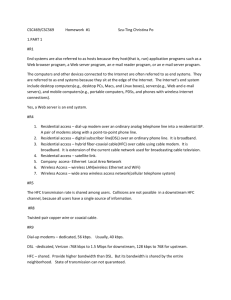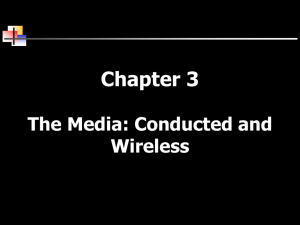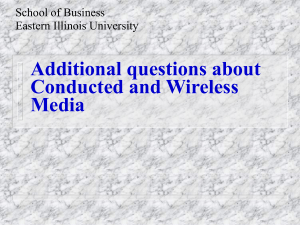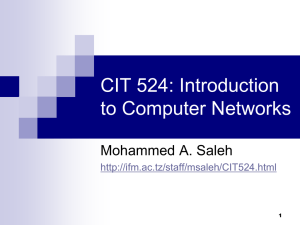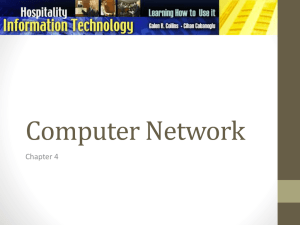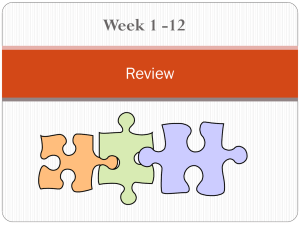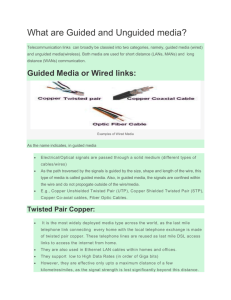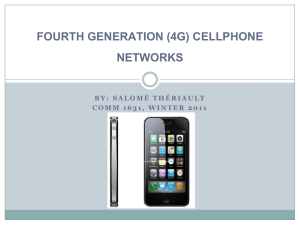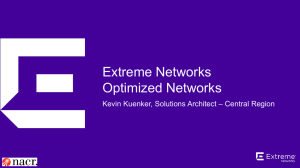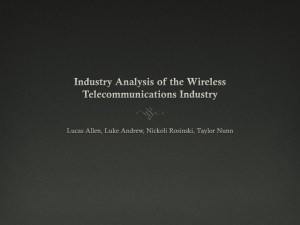Chapter 3
advertisement
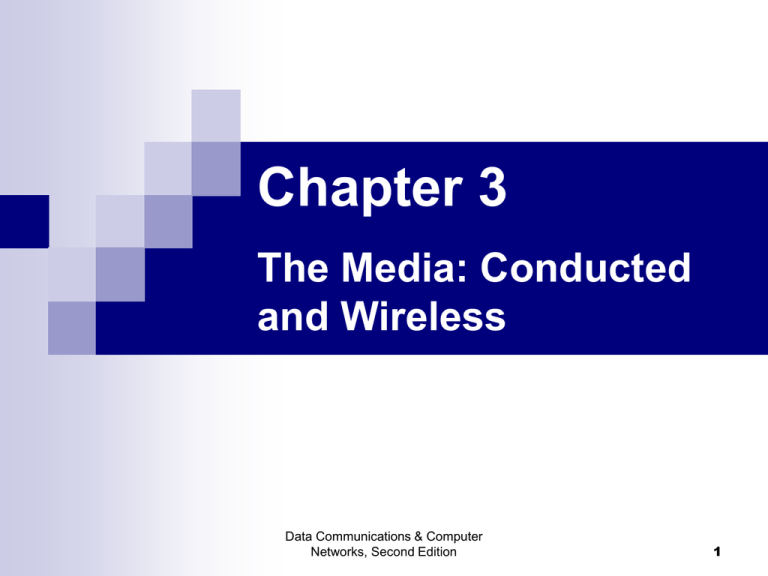
Chapter 3 The Media: Conducted and Wireless Data Communications & Computer Networks, Second Edition 1 Introduction The world of computer networks and data communications would not exist if there were no medium by which to transfer data. The two major categories of media include: Conducted media (3 types) Wireless media (9 types) Data Communications & Computer Networks, Second Edition 2 Conducted Media Twisted Pair Wire Telephone Computer Network Coaxial Cable Cable TVs Computer Network Long-distance telephone Fiber Optic Cable Computer Network Data Communications & Computer Networks, Second Edition 3 Twisted Pair Wire Two or more pairs of single conductor wires that have been twisted around each other. Twisted pair wire is classified by category. Twisted pair wire is currently Category 1 through Category 5e. Twisting the wires helps to eliminate electromagnetic interference between the two wires. Shielding can further help to eliminate interference. Data Communications & Computer Networks, Second Edition 4 Data Communications & Computer Networks, Second Edition 5 Data Communications & Computer Networks, Second Edition 6 Data Communications & Computer Networks, Second Edition 7 Coaxial Cable A single wire wrapped in a foam insulation surrounded by a braided metal shield, then covered in a plastic jacket. Cable can be thick or thin. Baseband coaxial (Thin) Broadband coaxial (Thick) Data Communications & Computer Networks, Second Edition 8 Data Communications & Computer Networks, Second Edition 9 Data Communications & Computer Networks, Second Edition 10 Fiber Optic Cable A thin glass cable approximately a little thicker than a human hair surrounded by a plastic coating and packaged into an insulated cable. A photo diode or laser generates pulses of light which travel down the fiber optic cable and are received by a photo receptor. Advantage Data Communications & Computer Networks, Second Edition 11 Data Communications & Computer Networks, Second Edition 12 Data Communications & Computer Networks, Second Edition 13 It is very common to mix fiber with twisted pair in LANs Data Communications & Computer Networks, Second Edition 14 Data Communications & Computer Networks, Second Edition 15 Wireless Media Terrestrial microwave Satellite transmission Cellular telephone systems Personal communication systems Pagers Infrared transmissions Bluetooth for short range transmission WAP Multipoint distribution services Data Communications & Computer Networks, Second Edition 16 Data Communications & Computer Networks, Second Edition 17 Terrestrial Microwave Land-based, line-of-sight transmission Approximately 20-30 miles maximum between towers Transmits data at hundreds of millions of bits per second Popular with telephone companies and business to business transmissions Data Communications & Computer Networks, Second Edition 18 Data Communications & Computer Networks, Second Edition 19 Often the microwave antennas are on towers and buildings. Data Communications & Computer Networks, Second Edition 20 Satellite Microwave Similar to terrestrial microwave except the signal travels from a ground station on earth to a satellite and back to another ground station. Satellites can be classified by how far out into orbit each one is (LEO, MEO, GEO, and HEO). Data Communications & Computer Networks, Second Edition 21 Satellite Microwave LEO MEO Low Earth Orbit 100 miles to 1000 miles pagers, wireless e-mail, special mobile telephones, spying, videoconferencing Middle Earth Orbit 1000 to 22,300 miles GPS and government. GEO Geosynchronous Orbit 22,300 miles weather, television, and government operations Data Communications & Computer Networks, Second Edition 22 Data Communications & Computer Networks, Second Edition 23 Satellite Microwave HEO Highly Elliptical Orbit A fourth type of orbit used by the military for spying and by scientific organizations for photographing celestial bodies. When satellite is far out into space, it takes photos. When satellite is close to earth, it transmits Data Communications & Computer Networks, Second Edition 24 Data Communications & Computer Networks, Second Edition 25 Mobile Telephone Wireless telephone service, such as cellular telephone, cell phone, and PCS. To support multiple users in a metropolitan area (market), the market is broken into cells. Each cell has its own transmission tower and set of assignable channels. Data Communications & Computer Networks, Second Edition 26 Data Communications & Computer Networks, Second Edition 27 Data Communications & Computer Networks, Second Edition 28 Mobile Telephone AMPS D-AMPS Advanced Mobile Phone Service First popular mobile phone service uses analog signals dynamically assigned frequency division multiplexing Digital Advanced Mobile Phone Service Applies digital time division multiplexing on top of AMPS PCS Personal Communication Systems Newer all-digital mobile phone service (2nd generation) Data Communications & Computer Networks, Second Edition 29 Mobile Telephone PCS phones come in three technologies: TDMA Time division multiple access CDMA Code division multiple access GSM Global system for mobile communications 3G – Third generation wireless (Internet/data access) Data Communications & Computer Networks, Second Edition 30 Blacksburg-Area Wireless Providers Verizon Verizon AT&T SunCom Nextel Sprint MCI Analog Digital Digital Digital Digital Digital Digital AMPS CDMA TDMA TDMA iDEN (TDMA) CDMA TDMA Data Communications & Computer Networks, Second Edition 31 Cellular Digital Packet Data Technology that supports a wireless connection for the transfer of computer data from a mobile location to the public telephone network and the Internet. Can be used in conjunction with mobile telephones and laptop computers. All digital transfer but relatively slow at 19,200 bps. Emergency services make use of CDPD. Data Communications & Computer Networks, Second Edition 32 Pagers Typically one-way communication service that uses ground-based and sometimes satellite-based systems. Some systems are two-way. Some systems can transmit small text messages Data Communications & Computer Networks, Second Edition 33 Infrared Transmissions Special transmissions that use a focused ray of light in the infrared frequency range. Very common with remote control devices, but can also be used for device-to-device transfers, such as PDA to computer. Will infrared last? Data Communications & Computer Networks, Second Edition 34 Bluetooth A Radio Frequency specification for short-range, point-to-multipoint voice and data transfer. Through solid, non-metal objects. Range from 10 cm to 10 m, but can be extended to 100 m by increasing the power. Connect to a wide range of computing and telecommunication devices without the need of connecting cables. Typical uses include phones and pagers, modems, LAN access devices, headsets, notebooks, desktop computers, and PDAs. Data Communications & Computer Networks, Second Edition 35 WAP (Wireless Application Protocol) WAP allows wireless devices such as mobile telephones, PDAs, pagers, and two-way radios to access the Internet. WAP is designed to work with small screens and with limited interactive controls. WAP incorporates Wireless Markup Language (WML) which is used to specify the format and presentation of text on the screen. Data Communications & Computer Networks, Second Edition 36 Data Communications & Computer Networks, Second Edition 37 Broadband Wireless Systems Delivers Internet services into homes and businesses. Designed to bypass the local loop telephone line. Transmits voice, data and video over high frequency radio signals. Data Communications & Computer Networks, Second Edition 38 Data Communications & Computer Networks, Second Edition 39 Broadband Wireless Systems Local multipoint distribution system (LMDS) digital data, video, Internet access millions of bps 28 GHz – 30 GHz but only a few miles Multichannel multipoint distribution service (MMDS) supports digital data, video, Internet access millions of bps 2.5 GHz 30-35 miles Data Communications & Computer Networks, Second Edition 40 Wireless LAN (IEEE 802.11) This technology transmits data between workstations and local area networks using high speed radio frequencies. Current technology (and protocol) allows for 11 Mbps data transfer at distances up to hundreds of feet. More on this in Chapter Seven (LANs) Data Communications & Computer Networks, Second Edition 41 Media Selection Criteria Data Communications & Computer Networks, Second Edition 42 Conducted Media In Action How do we wire a local area network? Remember: using Category 5 unshielded twisted pair, the maximum segment length is 100 meters. A wall jack is a passive device and does not regenerate a signal. Hub to hub connections are often fiber optic cable. Data Communications & Computer Networks, Second Edition 43 Data Communications & Computer Networks, Second Edition 44 Interconnecting Two Buildings Two buildings are separated by 400 meters. How do we interconnect them? Twisted pair? (Do we even have access?) Coaxial cable? Fiber? Wireless? Other? (Chapter 12) Data Communications & Computer Networks, Second Edition 45 Wireless Media In Action DataMining Corporation has one office in Chicago and one in Los Angeles. There is a need to transmit large amounts of data between the two sites. DataMining is considering using a Very Small Aperture Terminal satellite system. Cost is proportional to high amount of traffic with very high reliability. Speed is high enough to support company’s needs. Distance can easily expand across the U.S. Satellite systems are robust in most environments. Security can be very good with encryption. Data Communications & Computer Networks, Second Edition 46 Data Communications & Computer Networks, Second Edition 47
